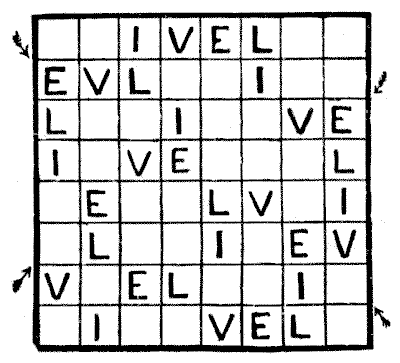(related to Problem: Under the Veil)
Some schemes give more diagonal readings of four letters than others, and we are at first tempted to favor these, but this is a false scent because what you appear to gain in this direction you lose in others. Of course, it immediately occurs to the solver that every $L I V E$ or $E V I L$ is worth twice as much as any other word since it reads both ways and always counts as $2.$ This is an important consideration, though sometimes those arrangements that contain most readings of these two words are fruitless in other words, and we lose in the general count.

The above diagram is in accordance with the conditions requiring no letter to be in line with another similar letter, and it gives twenty readings of the five words — six horizontally, six vertically, four in the diagonals indicated by the arrows on the left, and four in the diagonals indicated by the arrows on the right. This is the maximum.
Four sets of eight letters may be placed on the board of sixty-four squares in as many as $604$ different ways, without any letter ever being in line with a similar one. This does not count reversals and reflections as different, and it does not take into consideration the actual permutations of the letters among themselves; that is, for example, making the $L$'s change places with the $E$'s. Now it is a singular fact that not only do the twenty word-readings that I have given prove to be the real maximum, but there is actually only that one arrangement from which this maximum may be obtained. But if you make the $V$'s change places with the $I$'s, and the $L$'s with the $E$'s, in the solution given, you still get twenty readings — the same number as before in every direction. Therefore there are two ways of getting the maximum from the same arrangement. The minimum number of readings is zero — that is, the letters can be so arranged that no word can be read in any of the directions.
This eBook is for the use of anyone anywhere in the United States and most other parts of the world at no cost and with almost no restrictions whatsoever. You may copy it, give it away or re-use it under the terms of the Project Gutenberg License included with this edition or online at http://www.gutenberg.org. If you are not located in the United States, you'll have to check the laws of the country where you are located before using this ebook.